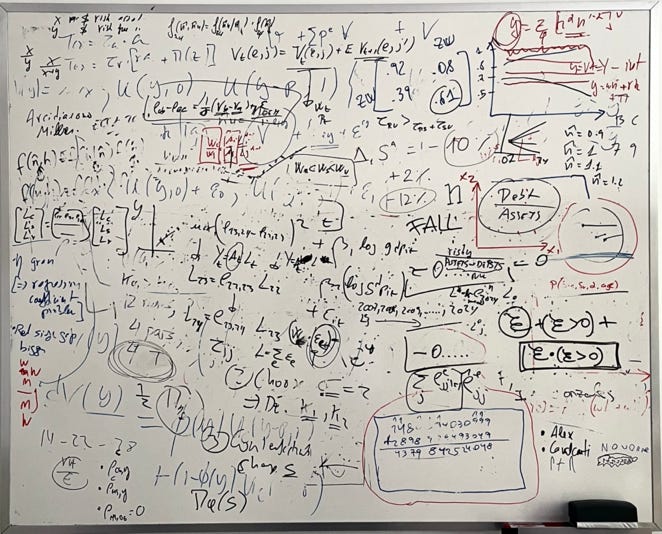Current Projects
Structural Change Accounting
with Manuel García-Santana, Lucciano Villacorta
Health, Consumption, and Inequality
with Jay Hong, Víctor Ríos-Rull
Inequality in Working Opportunities
Working Papers

Education, Lifestyles, and Health Inequality
with Jesús Bueren, Dante Amengual
Downloads: CEPR DP19990 (March 2025)
Status: R&R at Journal of Political Economy
Abstract: We study the effect of lifestyles on the education gradient of life expectancy. We use panel data on health behavior and health outcomes to estimate latent lifestyle types and their impact on health dynamics. We find that the higher frequency of health-protective lifestyles among the more educated individuals explains almost 1/2 of the education gradient in life expectancy. To understand lifestyle formation, we build a life cycle model where lifestyles and education are jointly chosen early in life. These two investments are complementary because of the more educated's higher income and the higher yield of their health-protective behavior. Importantly, with these complementarities, individuals with lower costs of healthier lifestyles self-select into higher education. Quantitatively, we find the three mechanisms similarly important in explaining the correlation between education and healthy lifestyles. We also find that the increase in the college wage premium over the last decades has widened the education gradient in lifestyles, resulting in a one-year increase in the education gradient of life expectancy across cohorts born in the 1930s and 1970s. Of this increase, 40% is driven by the direct effect of wage changes and 60% by the induced changes in the composition of college graduates and high school dropouts.
Macroeconomic Development, Rural Exodus, and Uneven Industrialization
with Tomas Budí-Ors
Downloads: Working paper (June 2025); CEPR Discussion Paper DP17086 (December 2022); first version March 2022
Status: R&R at Journal of Political Economy: Macroeconomics
Abstract: Economic development and industrialization are typically led by a few regions within a country. The initially laggard regions may catch up and industrialize (U.S. 1880-1940) or they may fail to industrialize, experience a population exodus, and help industrialization elsewhere (Spain 1940-2000). We build a model of structural change with multiple locations and sectors to uncover the economic forces shaping the emergence of these different patterns of development. We calibrate the economy to the development experience of Spain, and find that its large rural exodus and uneven regional industrialization originated from a decline in migration costs towards the most industrialized areas..
Dual Labor Markets and the Equilibrium Distribution of Firms
with Pau Roldan-Blanco
Downloads: CEPR Discussion Paper DP17762 (November 2025); first version July 2022
Abstract: We study how the co-existence of fixed-term (FT) and open-ended (OE) contracts shapes firm dynamics, firm selection, worker allocation, aggregate productivity, and output. Using rich Spanish administrative data, we document that the use of fixed-term contracts is very heterogeneous across firms within narrowly defined sectors. Particularly, the relationship between the share of temporary workers and firm size is positive within firm but negative between firms. To explain these facts, we write a model of firm dynamics with technology heterogeneity, search-and-matching frictions, and a two-tier labor market structure. Our model emphasizes a key trade-off between contracts, namely, that while FT contracts give flexibility to firms, they also create more worker turnover, which is costly through the need to hire new workers and through the loss of firm-specific human capital. We find that limiting the use of FT contracts decreases the share of temporary employment and increases aggregate productivity --as better firm selection offsets increased misallocation of workers-- but it also increases unemployment, output, and welfare.
Dual Labor Markets in Spain: a Firm-Side Perspective
with Ivan Auciello-Estevez, Federico Tagliati, Pau Roldan-Blanco
Downloads: Working paper (Banco de España, Documentos Ocasionales, #2310, April 2023)
An empirical companion paper to “Dual Labor Markets and the Equilibrium Distribution of Firms”
Old Working Papers
Durable Goods, Borrowing Constraints and Consumption Insurance
with Enzo Cerletti
Downloads: Working paper (May 2014, first version June 2012)
Abstract: We analyze the transmission of income shocks into durable consumption goods. We show that binding borrowing constraints lead to a substitution between goods of different durability upon arrival of an unexpected income change. The sign of this substitution depends on the persistence of the shock, whereas its size depends on the durability of goods and on their role as collateral for borrowing. An important consequence is that the response of nondurable consumption to income shocks may be an imperfect measure of household insurance against labor market risk. We use a calibrated two-good life-cycle model with labor market uncertainty and incomplete markets to quantify the actual amount of insurance implied by the observed transmission of income shocks to nondurable consumption. We find that young households have substantially less insurance against transitory shocks and more insurance against permanent shocks than commonly thought.
The Effects of Labor Market Conditions on Working Time: the US-EU Experience
with Claudio Michelacci
Downloads: working paper (September 2008)
Abstract: We consider a labor market search model where, by working longer hours, individuals acquire greater skills and thereby obtain better jobs. We show that job inequality, which leads to within-skill wage differences, gives incentives to work longer hours. By contrast, a higher probability of losing jobs, a longer duration of unemployment, and in general a less tight labor market discourage working time. We show that the different evolution of labor market conditions in the US and in Continental Europe over the last three decades can quantitatively explain the diverging evolution of the number of hours worked per employee across the two sides of the Atlantic. It can also explain why the fraction of prime age male workers working very long hours has increased substantially in the US, after reverting a trend of secular decline.